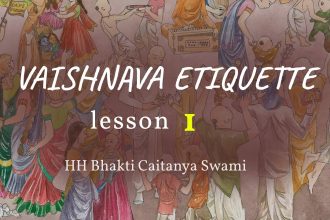TEXT 30
yo māṁ paśyati sarvatra
sarvaṁ ca mayi paśyati
tasyāhaṁ na praṇaśyāmi
sa ca me na praṇaśyati
SYNONYMS
yaḥ—whoever; mām—Me; paśyati—sees; sarvatra—everywhere; sarvam—everything; ca—and; mayi—in Me; paśyati—sees; tasya—for him; aham—I; na—not; praṇaśyāmi—am lost; saḥ—he; ca—also; me—to Me; na—nor; praṇaśyati—is lost.
TRANSLATION
For one who sees Me everywhere and sees everything in Me, I am never lost, nor is he ever lost to Me.
PURPORT
A person in Kṛṣṇa consciousness certainly sees Lord Kṛṣṇa everywhere, and he sees everything in Kṛṣṇa. Such a person may appear to see all separate manifestations of the material nature, but in each and every instance he is conscious of Kṛṣṇa, knowing that everything is a manifestation of Kṛṣṇa’s energy. Nothing can exist without Kṛṣṇa, and Kṛṣṇa is the Lord of everything—this is the basic principle of Kṛṣṇa consciousness. Kṛṣṇa consciousness is the development of love of Kṛṣṇa—a position transcendental even to material liberation. At this stage of Kṛṣṇa consciousness, beyond self-realization, the devotee becomes one with Kṛṣṇa in the sense that Kṛṣṇa becomes everything for the devotee and the devotee becomes full in loving Kṛṣṇa. An intimate relationship between the Lord and the devotee then exists. In that stage, the living entity can never be annihilated, nor is the Personality of Godhead ever out of the sight of the devotee. To merge in Kṛṣṇa is spiritual annihilation. A devotee takes no such risk. It is stated in the Brahma-saṁhitā (5.38):
premāñjana-cchurita-bhakti-vilocanena
santaḥ sadaiva hṛdayeṣu vilokayanti
yaṁ śyāmasundaram acintya-guṇa-svarūpaṁ
govindam ādi-puruṣaṁ tam ahaṁ bhajāmi
“I worship the primeval Lord, Govinda, who is always seen by the devotee whose eyes are anointed with the pulp of love. He is seen in His eternal form of Śyāmasundara, situated within the heart of the devotee.”
At this stage, Lord Kṛṣṇa never disappears from the sight of the devotee, nor does the devotee ever lose sight of the Lord. In the case of a yogī who sees the Lord as Paramātmā within the heart, the same applies. Such a yogī turns into a pure devotee and cannot bear to live for a moment without seeing the Lord within himself.
TEXT 31
sarva-bhūta-sthitaṁ yo māṁ
bhajaty ekatvam āsthitaḥ
sarvathā vartamāno ‘pi
sa yogī mayi vartate
SYNONYMS
sarva-bhūta-sthitam—situated in everyone’s heart; yaḥ—he who; mām—Me; bhajati—serves in devotional service; ekatvam—in oneness; āsthitaḥ—situated; sarvathā—in all respects; varta-mānaḥ—being situated; api—in spite of; saḥ—he; yogī—the transcendentalist; mayi—in Me; vartate—remains.
TRANSLATION
Such a yogī, who engages in the worshipful service of the Supersoul, knowing that I and the Supersoul are one, remains always in Me in all circumstances.
PURPORT
A yogī who is practicing meditation on the Supersoul sees within himself the plenary portion of Kṛṣṇa as Viṣṇu—with four hands, holding conchshell, wheel, club and lotus flower. The yogī should know that Viṣṇu is not different from Kṛṣṇa. Kṛṣṇa in this form of Supersoul is situated in everyone’s heart. Furthermore, there is no difference between the innumerable Supersouls present in the innumerable hearts of living entities. Nor is there a difference between a Kṛṣṇa conscious person always engaged in the transcendental loving service of Kṛṣṇa and a perfect yogī engaged in meditation on the Supersoul. The yogī in Kṛṣṇa consciousness—even though he may be engaged in various activities while in material existence—remains always situated in Kṛṣṇa. This is confirmed in the Bhakti-rasāmṛta-sindhu (1.2.187) of Śrīla Rūpa Gosvāmī: nikhilāsv apy avasthāsu jīvan-muktaḥ sa ucyate. A devotee of the Lord, always acting in Kṛṣṇa consciousness, is automatically liberated. In the Nārada-pañcarātra this is confirmed in this way:
dik-kālādy-anavacchinne
kṛṣṇe ceto vidhāya ca
tan-mayo bhavati kṣipraṁ
jīvo brahmaṇi yojayet
“By concentrating one’s attention on the transcendental form of Kṛṣṇa, who is all-pervading and beyond time and space, one becomes absorbed in thinking of Kṛṣṇa and then attains the happy state of transcendental association with Him.”
Kṛṣṇa consciousness is the highest stage of trance in yoga practice. This very understanding that Kṛṣṇa is present as Paramātmā in everyone’s heart makes the yogī faultless. The Vedas (Gopāla-tāpanī Upaniṣad 3.2) confirm this inconceivable potency of the Lord as follows: eko ‘pi san bahudhā yo ‘vabhāti. “Although the Lord is one, He is present in innumerable hearts as many.” Similarly, in the smṛti-śāstra it is said:
eka eva paro viṣṇuḥ
sarva-vyāpī na saṁśayaḥ
aiśvaryād rūpam ekaṁ ca
sūrya-vat bahudheyate
“Viṣṇu is one, and yet He is certainly all-pervading. By His inconceivable potency, in spite of His one form, He is present everywhere, as the sun appears in many places at once.”
















